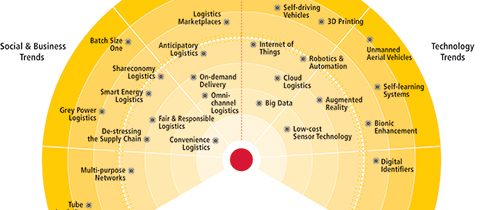Artificial intelligence is transforming logistics
Data-driven and autonomous supply chains will provide an opportunity for “previously unimaginable levels of optimization” in manufacturing, logistics, warehousing and last mile delivery, according to DHL’s 2016 Logistics Trend Radar.
The new report asserts that worldwide supply chains are beginning to undergo a fundamental transformation as more “artificial intelligence” is deployed to handle both the domestic and international movement of goods. The report further states such developments could become a reality in less than five years, despite high set-up costs deterring early adoption within the logistics industry.
Augmented reality (AR) technology is one such development that allows for machine-human interaction and collaboration. One example of this technology in use is “smart glasses” for order picking in logistics (also known as “vision picking”). A pilot program using vision picking by DHL showed a 25% efficiency increase as well as strong positive feedback from the users.
Robotics and automation is another area that will see further adoption within the next five years, particularly “collaborative robots” that work side-by-side with human employees, supporting repetitive and physically demanding tasks in logistics. DHL also said it has made inroads in logistics, with autonomous forklifts and other self-piloted equipment now “reaching a level of maturity” in warehouse operations.
The next step for self-driving vehicles in logistics will be to overcome regulatory and security challenges to deploy autonomous vehicles on public roads, according to the report. While unmanned aerial drone will require more than five years for widespread adoption, DHL believes that some products may no longer be manufactured in large mass-production facilities and shipped around the globe.
Instead, product designs will be digitized and transmitted to small factories closer to the customers, allowing for what DHL dubs “hyper-customization” of products and “batch size one” manufacturing – all requiring new logistics service concepts.
While the “Internet of Things” or “IoT” will also play a large role in more “intelligent supply chains” as well – a trend DHL noted in its trend report last year – security concerns regarding hacking, among other issues, is slowing down its adoption. IoT offers the potential to connect virtually anything to the Internet and accelerate data-driven logistics, DHL stressed; estimating that by 2020, more than 50 billion objects will be connected to the Internet, presenting an “immense” $1.9 trillion opportunity in logistics.
According to DHL, the slower adoption of IoT is largely due to a shortage of standards in the industry, security concerns, and the fact that recent IoT innovations have mainly been developed for the consumer market. Therefore, logistics will have to wait until similar ruggedized versions that meet business requirements come to market.
The digital always-on supply chain is also the subject of the 2016 MHI Annual Industry Report now available for download.





